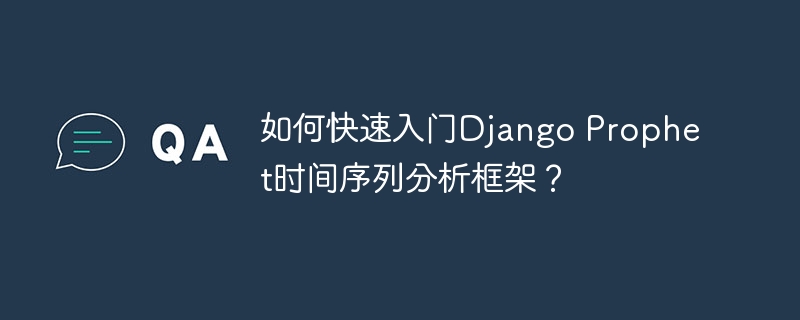

How to quickly get started with the Django Prophet time series analysis framework?
Introduction:
Time series analysis is an important method for prediction, analysis and model building of time series data. In Python, Django Prophet is a popular time series analysis framework based on Facebook's Prophet library and can be seamlessly integrated with the Django framework. This article will introduce how to quickly get started using Django Prophet for time series analysis in a Django project, and provide specific code examples.
1. Install Django Prophet
First, you need to install Django Prophet in the project. You can use the following command to install:
pip install django-prophet
2. Create a Django time series model
python manage.py startapp timeseries
from django.db import models
class TimeSeries(models.Model):
date = models.DateField() value = models.FloatField()
3. Import data
In the created time series model, we need to import time sequence data.
from django.shortcuts import render
from .models import TimeSeries
def import_data(request):
# 调用时间序列数据导入函数 data = load_data() # 将数据保存到数据库中 for entry in data: TimeSeries.objects.create(date=entry['date'], value=entry['value']) return render(request, 'import_success.html')
import csv
def load_data():
data = [] with open('data.csv', 'r') as file: reader = csv.DictReader(file) for row in reader: entry = {'date': row['date'], 'value': float(row['value'])} data.append(entry) return data
4. Time series analysis and forecast
from prophet import Prophet
def analyze():
# 从数据库中获取时间序列数据 data = TimeSeries.objects.all().values('date', 'value') # 创建一个Prophet对象 prophet = Prophet() # 为Prophet对象传入时间序列数据 prophet.fit(data) # 创建一个日期范围以进行预测 future = prophet.make_future_dataframe(periods=365) # 进行预测 forecast = prophet.predict(future) return forecast
from .models import TimeSeries
def analysis(request):
# 调用时间序列分析函数 forecast = analyze() # 将分析结果传递给模板 return render(request, 'analysis_result.html', {'forecast': forecast})
5. Display the analysis results
{% for entry in forecast %}
{{ entry.date }}
{{ entry.yhat }}
{% endfor %}
from .models import TimeSeries
def analysis(request):
# 调用时间序列分析函数 forecast = analyze() # 将分析结果传递给模板 return render(request, 'analysis_result.html', {'forecast': forecast})
6. Run the Django project
Enter in the command line In the directory where the Django project is located, run the following command to start the Django development server:
python manage.py runserver
7. Precautions for using Django Prophet for time series analysis
Conclusion:
Through the above steps, we can quickly integrate the Django Prophet framework in the Django project and perform time series analysis and prediction. Of course, specific use and parameter adjustment require further study and practice based on actual needs. I hope this article can provide some help for everyone to quickly get started with the Django Prophet time series analysis framework.
The above is the detailed content of How to quickly get started with the Django Prophet time series analysis framework?. For more information, please follow other related articles on the PHP Chinese website!




